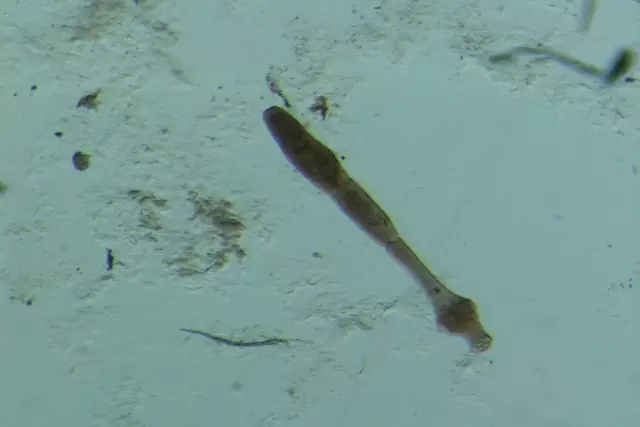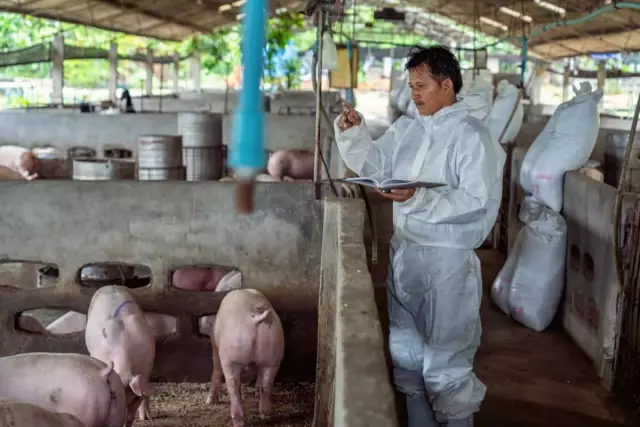- Author Rachel Wainwright [email protected].
- Public 2023-12-15 07:39.
- Last modified 2025-11-02 20:14.
Echinococcosis
Brief description of the disease
Echinococcosis is a chronic helminthic disease caused by the tapeworm ekinococcus. Not only people get sick, but also animals. Most often, infection with echinococcosis occurs after contact with dogs or while shearing sheep. Features of the transmission mechanism determine the ubiquitous prevalence of infection. In our country, it occurs in all regions, but the largest number of cases is detected in areas with developed animal husbandry.
Causative agents of infection and mechanisms of development of the disease

Tapeworms parasitize the intestines of sheep, dogs and rodents. There they lay eggs, which then enter the external environment with animal feces. Helminth eggs penetrate into the human body if the rules of personal hygiene and the required level of sanitation are not followed, and when echinococcosis is diagnosed, symptoms of infection can appear in a variety of organs. The main danger of echinococcosis is that with the blood, helminths are carried through all vital systems and turn into Finns - cysts, in which the final formation of the parasite takes place. As the causative agents of echinococcosis grow, the Finns also grow in size and begin to squeeze nearby tissues, disrupting the normal functioning of organs. Most often, cysts are found in the liver (liver echinococcosis) and in the lungs. They sometimes affect the brain.
How does echinococcosis manifest itself, symptoms of the disease
In most cases, echinococcosis is completely asymptomatic. Often there is a situation when it is possible to detect echinococcosis in children and adults only with prophylactic X-ray and ultrasound examinations. If the helminths progress to the stage of cysts, then they begin to squeeze the adjacent organs and tissues. At this stage, the symptoms of echinococcosis are more pronounced. Patients have various symptoms, depending on the location of the Finn. So, for example, liver echinococcosis is accompanied by:
- pain in the right hypochondrium;
- a feeling of heaviness in the right side of the body;
- pressure on the liver;
- weakness;
- constant malaise;
- rapid fatigue even with minor physical exertion;
- decrease in physical activity;
- allergic reactions (not always manifest);
- yellowing of the skin.
The pulmonary form of echinococcosis leads to pain in the chest, cough, shortness of breath. If a person develops echinococcosis of the brain, the symptoms are of a neurological nature. Most often, patients suffer from paralysis, paresis, seizures, and mental disorders.
Diagnosis of echinococcosis

The presence of helminths in the human body is confirmed using imaging laboratory research methods. Typically, doctors use X-rays, MRIs, CTs and ultrasounds for this. Previously, along with the above methods, a puncture biopsy of a cyst was also used, however, today it is considered dangerous, since during the procedure, parasites can spread to surrounding organs and tissues. Also, immunological methods are not used to diagnose echinococcosis, which is associated with their low information content.
Echinococcosis treatment
The choice of a method for treating echinococcosis depends on the location of the helminths, the general condition of the patient and the clinical picture of the development of the infection. In most cases, a decision is made about surgical intervention, unless, of course, it poses a threat to the patient's life. During the operation, the cyst is removed with subsequent suturing of the cavity left after the formation was removed.
Prevention of echinococcosis
When preventing echinococcosis, the following rules must be observed:
- do not allow small children to play with dogs;
- wash hands after working in the garden, before eating, after skinning sheep and skinning animals;
- regularly carry out preventive examinations of domestic dogs, register them in veterinary institutions;
- handle food before eating;
- do not drink raw water from open reservoirs and city water supply systems;
- slaughter cattle in specially designated places;
- if your work is related to animals, then it is necessary to be regularly tested for echinococcosis.
As you can see, the rules are really simple, but their observance will prevent not only echinococcosis, but also many other diseases of the gastrointestinal tract.
YouTube video related to the article:
The information is generalized and provided for informational purposes only. At the first sign of illness, see your doctor. Self-medication is hazardous to health!






